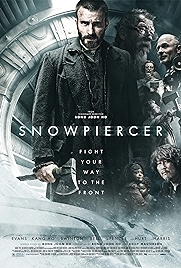That sound? The plane taking off from LAX taking another great Asian director back home, sobbing with disappointment. It happened to John Woo, who did at least manage to crank out Face/Off, but his sad run of Hollywood films include Windtalkers, Mission: Impossible II and Hard Target. To the Pang brothers too, whose The Eye was one of the attention-grabbers of 2002. They came to Hollywood, made The Messengers for Sam Raimi, then put their tail between their legs and went home.
So what about the latest Asian import, the great South Korean director Bong Joon Ho, whose uniquely flavoured movies include Memories of Murder, a killer-thriller-whodunit whose cops get their man more by brutality and naked luck than sleuthing. Or The Host, a monster movie in which the hero doesn’t so much step forward, as find that everyone else has taken a step back. How is Mr Bong going to fare in a town where irony is a dish best served not at all?
The answer is Snowpiercer, an adaptation of the 1982 cult French graphic novel Le Transperceneige, a post-apocalyptic thriller set on board a train of 1,001 carriages that has been travelling non-stop for 17 years through a world that is entirely frozen. Outside, the passengers are told, everything is extinct. Inside, the train is run on feudal Orwellian lines, with the bosses at the front, the proles at the back, and a massive system of repression, propaganda and eventism keeping everyone, but mostly the proles, on-message.
The uneasy equilibrium is disrupted when Curtis (Chris Evans) and sidekick Edgar (Jamie Bell) are emboldened by ragged spiritual mentor Gilliam (John Hurt) into making a break for the front of the train, to either overthrow Big Brother-style leader Wilford (Ed Harris) or convince him at least of the need for a little more gravy down the back end.
Post-apocalypse, little men against a corrupt leader, steampunk technology, a quest: we’ve seen films like this a lot over the decades, often starring Arnie or Will Smith or Tom Cruise, films that pause to crack a wry one-liner but are otherwise propulsive, fairly humourless and full of action and dead bodies.
The first sign that Bong isn’t quite making that sort of film comes early on, with the arrival of Mason (Tilda Swinton), one of Wilford’s henchpeople, who has come down from the front to the back to the train – and looks very unhappy about it too – to nip rebellion in the bud. In a convoluted speech Mason contemptuously tells the rear-dwellers that they should be happy with their lot, that everyone has their role and, pushing an ill-chosen metaphor beyond breaking point, that “I am the hat; you are the shoe”, all this while a miscreant is having his arm frozen off by exposure to the outside elements, pour encourager les autres. It’s the sort of scene you can imagine being in Total Recall, except that screenwriters Kelly Masterson and Bong Joon Ho have other ideas: Swinton comes equipped with a comic northern English accent, a face full of big teeth and her coat is constantly slipping off her shoulders.
The whole film is like this – familiar sci-fi tropes undermined by Bong’s oblique strategies.
I’m not going to explain the film’s entire plot, except to say that Curtis, Edgar, their ragged-trousered team and a couple of South Koreans (Song Kang-ho, Ko Ah-sung) woken from cryo-sleep do indeed make a dash for the front, each carriage a marvel of Wachowski-esque set design (one’s a classroom teaching elite kids, another is a vast glass house hydroponically growing crops, another is a bespoke tailor’s, another a dentist, a nightclub, a cocktail bar), through a train whose metaphorical purpose couldn’t be made more explicit if the word “allegory” were flashing up on screen every few minutes.
It is a fantastic, fabulous, ludicrous and lovely film to look at, and as Curtis and crew battle forwards they are assailed by bullets, bombs and even a medieval axe attack in one entirely blacked-out carriage. But one great, breathtaking and fanatically detailed scene followed by another doesn’t necessarily equal a great film. And that’s the case here. Partly this is Evans’s fault – he’s likeable but lacks heroic charisma. But mostly it’s because I think Bong wanted it that way. For example, in the middle of the medieval axe fight the combatants pause to wish each other a happy new year. Bong is deliberately subverting the heroic action blockbuster with little human touches (the slipping coat) at almost every turn.
But this deviously ironic film insisting on nuance where the genre generally goes for broad brush isn’t helped – is undermined, in fact – by its blunderbuss approach to satire. In particular the final long rambling “explains it all” speech by Wilford that more or less throws away the claims to specialness that the film has carefully wrought. Is this Bong’s doing? Masterson’s? The studio’s?
Snowpiercer isn’t boring, and there’s really nothing to touch it for production design and world-building. File it next to the Wachowskis’ Cloud Atlas in the drawer marked Mad Brilliant Messes with a Thumping Message.
Bong’s next film is being made in South Korea.
Snowpiercer – Watch it/buy it at Amazon
I am an Amazon affiliate
© Steve Morrissey 2014


